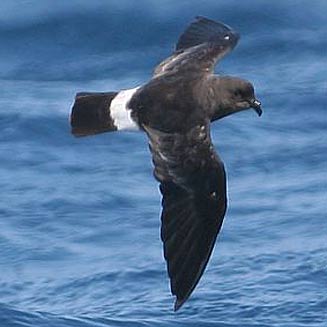|
Hydrobates pelagicus (European
storm-petrel)
Europese stormswael [Afrikaans]; (gewoon) stormvogeltje
[Dutch]; Océanite tempête [French]; Sturmschwalbe [German];
Painho-de-cauda-quadrada [Portuguese]
Life
> Eukaryotes >
Opisthokonta
> Metazoa (animals) >
Bilateria >
Deuterostomia > Chordata >
Craniata > Vertebrata (vertebrates) > Gnathostomata (jawed
vertebrates) > Teleostomi (teleost fish) > Osteichthyes (bony fish) > Class:
Sarcopterygii (lobe-finned
fish) > Stegocephalia (terrestrial
vertebrates) > Tetrapoda
(four-legged vertebrates) > Reptiliomorpha > Amniota >
Reptilia (reptiles) >
Romeriida > Diapsida > Archosauromorpha > Archosauria >
Dinosauria
(dinosaurs) > Saurischia > Theropoda (bipedal predatory dinosaurs) >
Coelurosauria > Maniraptora > Aves
(birds) > Order: Ciconiiformes
> Family: Hydrobatidae
 |
|
|
European storm-petrel, offshore from Cape Town, South Africa. [photo
Trevor Hardaker ©] |
|
Distribution and habitat
Breeds in Iceland, western Europe and possibly North
Africa, heading south in the non-breeding season to the coastline of Africa from
Mauritania to southern Africa. Here it is common along the coastline of Namibia
and South Africa up to East London, less common further out to sea, while more
scarce further north-east through KwaZulu-Natal to Mozambique.
Predators and parasites
It has been recorded as prey of the following animals:
Movements and migrations
It leaves its European breeding grounds from
August-October, migrating along the coast of western Europe and
Africa and eventually arriving in southern Africa in September. Its
numbers peak in the region from November-March, leaving for its
breeding grounds in May.
Food
It mainly eats crustaceans and small fish, doing most of
its foraging by immersing head or its entire body in the sea in order to grab
prey. The following food items have been recorded
in its diet:
- fish
- invertebrates
- crustaceans
- squid
- jellyfish
- remains of insects (presumably blown into the sea)
- other
- scraps from fishing vessels
- faeces of whales
Threats
Not globally threatened, although some colonies have
reduced in numbers or have been abandoned completely.
References
-
Hockey PAR, Dean WRJ and Ryan PG 2005. Roberts
- Birds of southern Africa, VIIth ed. The Trustees of the John Voelcker
Bird Book Fund, Cape Town.
|
